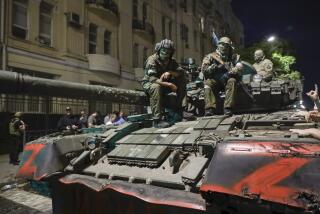31 Tanks Sent to Panzer Graveyard : East Germany Begins Military Cutback
- Share via
GOLDBERG, East Germany — A chill, biting wind whipped across the parade ground of the 8th Panzer Regiment here Friday as soldiers stood stiffly in formation.
Most of the regiment of several hundred men wore the field-gray uniform of the East German army. The rest--127 of them--wore jackets, jeans, sneakers and “goodby” kerchiefs. These were draftees who had completed their 18 months of service and were being discharged at this post, 90 miles northwest of divided Berlin.
As East German generals went out of the way to emphasize, the men being discharged are not being replaced.
This means that as the conscripts are phased out, so too will be the 8th Panzer Regiment, which was created in 1956 and is to be disbanded by October.
About 10 miles away, on a railroad siding in a pine forest on the North German Plain, a battalion of 31 tanks was moved onto flatcars of a train that later headed south. The aging bottle-green T-55s were destined for a panzer graveyard at Ostritz near the Polish border, where according to senior officers here, they are to be scrapped or cannibalized for parts or converted to coal mining equipment.
‘Difficult’ for Commander
“It is difficult for me personally to give them up,” said Maj. Manfred Wuelferling, the battalion’s 37-year-old commander, who wore panzer-black coveralls. “A great part of my life has been spent with them.”
As the battalion was retired, similar scenes were taking place in five other panzer regiments Friday, according to East German officers.
This was the well-publicized start of East Germany’s unilateral move to reduce its armed forces, now 176,000 strong, by 10,000 troops and 600 tanks by the end of next year.
“Today is unprecedented in the history of the East German army,” Lt. Gen. Horst Syllar, commander of the regional military district, said of the move.
He said that some front-line divisions, deprived of a tank regiment, would be transformed step by step into more “defensive operations.”
Staff officers confirmed that divisional formations will have to be restructured, but they did not spell out how.
Guarding Invasion Route
The tanks being retired Friday were taken from the 1st Motor Rifle Division, which is based near Schwerin and guards parts of the plain that stretches from the Soviet Union to the English Channel.
The plain, dotted with red-brick farmhouses and black-and-white dairy cattle, is classic tank country. In the view of military analysts, it would be the main route of any Soviet advance, through Poland, into Western Europe.
Military experts believe that any incursion by the Warsaw Pact powers would be aimed at reaching the Rhine River and the Low Countries--Belgium, Luxembourg and The Netherlands--while cutting off Denmark in the north and outflanking the U.S. 7th Army to the south.
In view of this, the fact that the East Germans are disbanding an armored regiment plus an air wing, rather than, say, an infantry unit, is seen in the West as a hopeful sign.
“It is armor capability that the Western Alliance has considered most dangerous,” a North Atlantic Treaty Organization official said. “So this is certainly a positive move on the part of the East Germans.”
Friday’s force reduction is scheduled to be followed May 5 by the withdrawal of some Soviet forces from East Germany. The Soviets are working on a timetable set out by President Mikhail S. Gorbachev in a speech to the United Nations last December.
Most of the Soviet forces in Warsaw Pact countries are stationed in East Germany, a total of 380,000 troops. Gorbachev said his government would withdraw about 5,000 tanks and 50,000 troops from East Germany, Czechoslovakia, and Hungary by the end of next year. Last week, a battalion of 31 tanks was loaded onto a train at Kiskunhalas in Hungary and moved off toward the Soviet Union.
No one in the West knows for certain whether the forces that the Communist governments say they are disbanding will actually disappear from the order of battle, or whether they will turn up again another day. But as one Western observer said Friday:
“I think the East Germans are serious. After all, these tanks are 20 years old and ready for the scrap heap anyway. The East German economy is short of young workers. They badly need the manpower.”
A U.S. diplomat added, “I think this is probably the real thing.”
An East German official said Friday that about 11,500 new conscripts are being diverted to civilian tasks after only three months of basic training. He said they will work at civilian jobs for the remaining 15 months of their compulsory service.
Although most NATO officials praised the reductions, one said, “They still have a lot of cutting to do before we are anywhere near parity in tanks.”
The Warsaw Pact reductions are calculated to appeal to West Germans and other Europeans. Yet, Michael Broer, of the Bonn-based Foreign Policy Institute, commented: “Sure, the Soviets are trying to use this for propaganda purposes. But there’s substance here as well.”
Some analysts speculated that the cuts are bound to be popular in Western Europe and will further roil the argument in NATO over new arms control measures.
More to Read
Sign up for Essential California
The most important California stories and recommendations in your inbox every morning.
You may occasionally receive promotional content from the Los Angeles Times.













